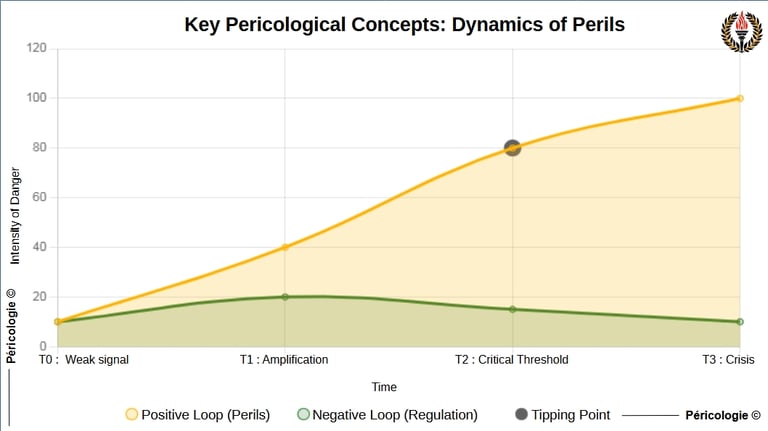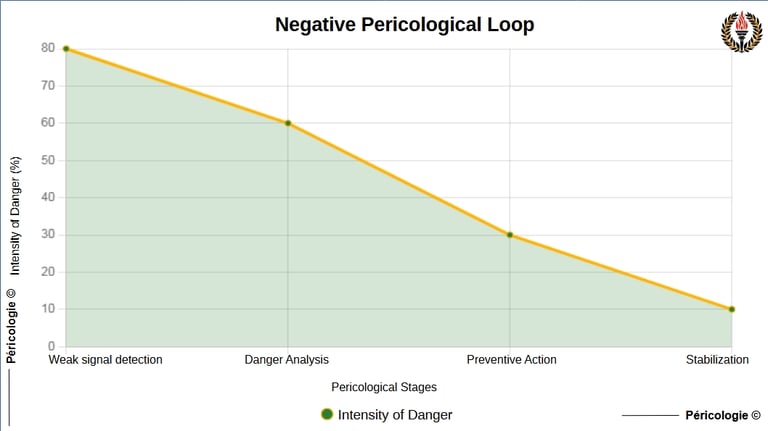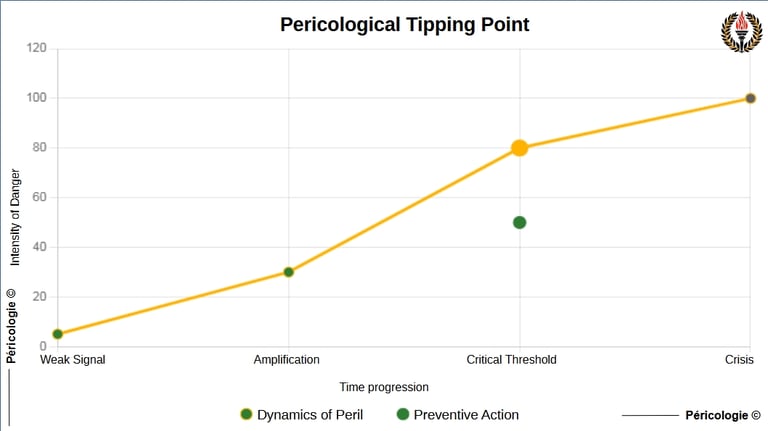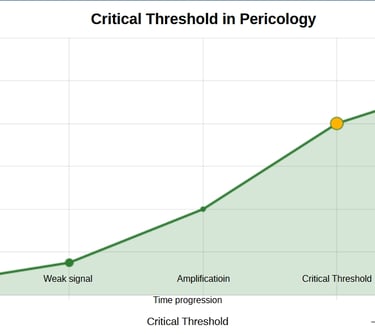Key Concepts of Pericology
Key Pericological Concept
The "Key Concepts " designate the fundamental mechanisms that govern the dynamics of perils within Pericology, to anticipate and prevent systemic crises. These concepts, inspired by the cooperative dynamics of nature (fauna and flora), make it possible to model, understand and counter perils before they reach a critical threshold. They include the positive loop (self-reinforcing amplification of perils, e.g., viral propagation in an ecosystem or social panic), the negative loop (regulatory mechanisms stabilizing a system, e.g., body thermal regulation), and the tipping point. Anchored in scientific rigor, these concepts translate biological observations into practical tools for human, technological or systemic contexts, promoting peripheral anticipation.


Key Pericological Concept
Diagram of the key pericological concept
Pericological Example
Context : In a coastal city, dune erosion due to frequent storms threatens local habitats and tourism infrastructure. Weak signals (e.g., decrease in stabilizing vegetation) are detected through pericological observation, but ignored by traditional coastal management approaches.
Pericological Application : Positive loop : Erosion accelerates sand loss, amplifying the vulnerability of dunes to storms (self-reinforcing). Negative loop : Inspired by ecosystems (e.g., plant roots fixing sand), Pericology suggests planting resistant plants to stabilize the dunes, regulating the danger. Tipping point : Identify the threshold where erosion becomes irreversible (e.g., 50% of dunes lost). Preventive action (planting before this threshold) blocks the crisis.
Etymology
The term "Key Concepts" comes from the Latin conceptus ("formed idea, thought") and the English key (from the Old English cǣg , "key"), meaning pivotal notions unlocking the understanding of complex dynamics.
Pericological : From the Latin periculum ("danger, risk") and the Greek peri ("around").
Pericological Sources
The Negative Pericological Loop
In Pericology, the "Pericological Negative Loop" refers to a systemic regulatory mechanism that mitigates or stabilizes a hazard before it reaches a critical threshold, drawing inspiration from the natural feedback dynamics observed in fauna and flora. This process counterbalances amplifying dynamics (positive loops) by mobilizing corrective actions based on the observation of weak or measurable signals. Unlike reactive approaches, the pericological negative loop acts proactively to prevent the escalation of biological, socio-cultural, technological or systemic hazards. It relies on collective coordination and self-management, adapted to local contexts, to maintain a systemic balance.


Negative Pericological Loop
Diagram of the Pericological Negative Loop
Pericological Example
Context : In a small farming community facing increasing soil erosion (emerging peril), farmers are observing declining yields (weak signal). Without intervention, this dynamic could reach a tipping point, rendering the land uncultivable.
Pericological Application : Pericologyapplies a negative loop inspired by forest ecosystems, where the plant cover stabilizes the soil. Farmers, through observation (pericologist as observer), identify the weak signal and analyze the cause (erosion by overgrazing). They act by planting plant hedges (preventive action), which reduce erosion and regulate the danger, preserving the balance of the agricultural system.
Etymology
Loop : From the old French " boucle " (12th century), from the Latin buccula ("small mouth" or "ring"), designating a closed cycle or feedback.
Negative : From the Latin negativus ("which denies" or "opposed"), indicating an action of attenuation or counterbalancing in the face of an amplifying dynamic.
Pericological : Derived from Pericology (Latin periculum , "danger", and Greek peri , "around"), emphasizing the peripheral anticipation of perils.
Pericological Sources
The Positive Pericological Loop
In Pericology, a "Pericological Positive Loop" refers to a self-reinforcing amplification mechanism by which a systemic peril, whether biological, human, technological or mixed, rapidly intensifies through cascading interactions. This concept, inspired by natural dynamics (e.g., propagation of a forest fire by wind reinforcing heat), identifies the thresholds where a weak signal becomes critical, risking a tipping point. Pericology uses it to detect these dynamics early and propose interventions before irreversible escalation. Unlike cybernetic positive loops, it is contextualized in peripheral anticipation, integrating bio-inspired and practical solutions.


Positive Pericological Loop
Diagram of the Positive Pericological Loop
Pericological Example
Context : In an interconnected technological system such as an IoT sensor network in an urban environment (e.g., logistics flow monitoring), an emerging hazard such as a minor overload (weak signal : 5% increased latency) is detected via peri-ecological observation. Without intervention, this overload self-amplifies : neighboring sensors compensate, increasing the overall load, creating a positive loop where the initial failure propagates cumulative errors (e.g., 20% then 50% latency in 24 hours), threatening the systemic balance (tipping point : cascading failure affecting transport and safety).
Pericological Application : Applying Ecosynpraxy, model the loop via natural feedback (e.g.: swarm of bees redistributing tasks to avoid overload). Proactive action : Deploy an analyzer to contrast dynamics (evaluate impact : critical threshold at 30% latency), then act by redistributing tasks via self-managed algorithms (e.g.: 10% reduction of load on adjacent sensors).
Etymology
Loop : From Old French " boucle " (13th century), derived from the Latin buccula ("small mouth" or "ring"), designating a cyclical or repetitive structure.
Positive : From the Latin positivus (“posited, affirmed”), indicating an amplification or reinforcement in a system.
Pericological : Derived from periculum (Latin, "danger") and péri (Greek, "around"), emphasizing the peripheral anticipation of dangerous dynamics .
Pericological Sources
The Pericological Tipping Point
The "Pericological Tipping Point" refers to the critical threshold at which a peril, whether biological, socio-cultural, technological or systemic, reaches a level of intensity such that it becomes an irreversible or difficult to control crisis. In Pericology, this concept identifies the moment at which peril dynamics (amplified by positive loops or mitigated by negative loops) exceed a point of equilibrium, leading to a systemic tipping point. This is a key indicator for proactive anticipation, allowing action to be taken before critical thresholds are crossed.


Pericological Tipping Point
Diagram of the pericological tipping point
Pericological Example
Context : A small project team in a technology company is facing work overload due to tight deadlines. Weak signals (decreased communication, increased fatigue) are detected through daily meetings but not addressed.
Pericological Application : Inspired by bio-inspired regulatory mechanisms (e.g., redistribution of resources in an ant colony), Pericology aims to identify the tipping point (risk of collective burnout threatening the project). The observer identifies the signals (e.g., frequent errors), the analyzer evaluates the threshold (e.g., 80% of members overloaded), and the action consists of reallocating tasks or integrating a structured break, blocking the danger before the crisis.
Etymology
The term derives from the French expression "point de bascule , from physical and mechanical vocabulary, where "bass" (from the Latin bascula , balance) evokes a pivot or a sudden change of state.
“Pericological” comes from the Latin periculum (danger, risk) and the Greek peri (around), emphasizing a peripheral and anticipatory approach to threats.
Pericological Sources
https://unu.edu/ehs/news/risk-tipping-points-pose-new-and-increased-threats
https://en.wikipedia.org/wiki/Tipping_points_in_the_climate_system
https://www.frontiersin.org/journals/climate/articles/10.3389/fclim.2022.1009234/full
https://www.ucl.ac.uk/bartlett/sites/bartlett/files/ecosystem_tipping_points_policy_report_iipp.pdf
The Critical Threshold
In Pericology, the "Critical Threshold" refers to the precise point where a peril, through its intensification or accumulation, reaches a level where it threatens to tip into an irreversible or difficult-to-control systemic crisis. This concept, central to the discipline, marks the boundary between a manageable state and a state where destabilization dynamics (often amplified by positive loops) escape regulatory mechanisms (negative loops). It is a key indicator for anticipation, allowing pericologists to identify the moment when proactive intervention becomes imperative to avoid a tipping point. In an ecosystem, it can correspond to a level of pollution where biodiversity begins to collapse. The critical threshold is measurable (via data or observations) and contextual, adapting to the specificities of human, biological or technological systems.


Critical Threshold
Critical threshold diagram
Pericological Example
Context : In an interconnected factory using IoT sensors to monitor production, a progressive overload of machines ( weak signal : 10% increase in energy consumption) threatens a cascading failure affecting the regional supply chain.
Pericological Application : A pericologist, using the Cyclosynpraxia approach, detects this weak signal using bio-inspired modeling (e.g., redistribution of flows in a forest ecosystem). Before the critical threshold is reached (total failure of the machines), he proposes a dynamic reallocation of tasks between machines, reducing the load by 15% and stabilizing the system. This preventive action, guided by the analysis of positive loops, avoids a logistics crisis
Etymology
Threshold : From the Latin sulium (or solum , base, ground), designating a physical or symbolic limit or border, like the step of a door
Criticism : From the Greek kritikos (from krinein , to judge, to discern), meaning a decisive moment or situation requiring precise judgment.
Pericological Sources
For enthusiasts
Our links
Message
© 2025. All rights reserved. By Pericology
